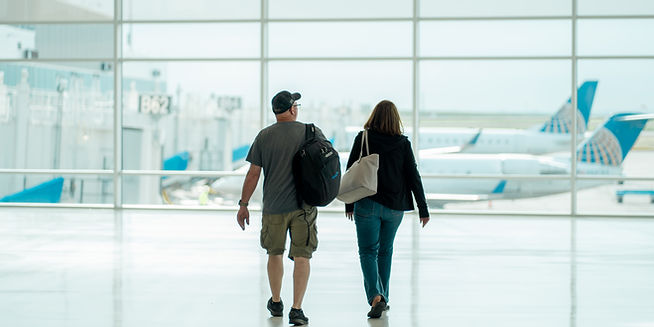How Early Should I Get to the Airport in 2025?
November 3, 2025 at 5:09:46 AM

Traveling in 2025 comes with new conveniences — digital boarding passes, self-check-in kiosks, and facial recognition gates — but also new challenges like unpredictable security lines and evolving airline policies. So, the classic traveler’s question still stands: how early should you really arrive at the airport?
Here’s a complete breakdown by flight type, airport size, and traveler situation — along with insider tips that can save you time, stress, and even money.
1. The Golden Rule (and Why It’s Still Relevant)
For years, airlines have recommended:
2 hours before domestic flights
3 hours before international flights
Even in 2025, this remains a safe guideline. But the reality is more nuanced — especially with the rollout of biometric check-ins, TSA PreCheck expansion, and automated baggage systems in major airports.
To figure out your perfect timing, you’ll need to consider:
Airport size and congestion level
Whether you’re checking a bag
Security line efficiency
The time of day and day of the week
Your airline’s check-in cutoff policy
2. Domestic Flights in 2025
For most U.S. airports, 90 minutes before departure is ideal for domestic travel — if you already checked in online and are traveling carry-on only.
If you need to check a bag, aim for 2 hours. Many airlines now have automated cutoffs — miss that deadline by even 5 minutes, and your bag won’t make the flight.
Pro Tip:
Southwest closes bag check 45 minutes before departure.
Delta and American typically close it 45–60 minutes before.
TSA PreCheck and CLEAR can cut 15–20 minutes from your wait time.
3. International Flights in 2025
International flights are a different story. Between passport control, visa verification, and secondary security checks, the 3-hour rule still stands strong.
If you’re flying to or from:
Asia or the Middle East, arrive 3 hours early.
Europe or South America, 2.5 hours can often suffice.
Smaller airports or off-peak hours, you can safely aim for 2 hours.
Many global hubs like London Heathrow, Singapore Changi, and Dubai International have added digital immigration gates, which can cut time in half — but if you’re not pre-registered, expect longer waits.
4. Time of Day Matters More Than You Think
Peak times at airports can change your experience completely.
Avoid these high-traffic windows if possible:
5–8 a.m. – Morning rush of business travelers
3–6 p.m. – Afternoon international departures
Sunday evenings & Monday mornings – Heaviest domestic travel days
If you’re flying during one of these peaks, add 30–45 minutes to your usual arrival time.
5. How Airport Size Impacts Timing
Not all airports are created equal:
Small regional airports (like Boise, Spokane, or Albany): often smooth and fast. 60–90 minutes may suffice.
Medium hubs (like San Diego, Austin, or Nashville): moderate crowds — 90 minutes is safe.
Major hubs (like LAX, JFK, or Chicago O’Hare): always budget 2–3 hours, even for domestic flights.
Some larger airports, including Atlanta (ATL) and Dallas–Fort Worth (DFW), now have real-time TSA wait time displays online — check those before you leave home.
6. Airline and Destination Policies Can Differ
Certain airlines enforce stricter check-in and boarding cutoffs:
International airlines like Emirates, Qatar Airways, and British Airways close boarding 60 minutes before departure.
Low-cost carriers like Frontier, Ryanair, and Spirit often stop check-in 45 minutes before.
It’s smart to confirm your airline’s rules before heading out. If you miss check-in, rebooking fees can easily exceed $100.
7. Tech Tools That Help You Time It Perfectly
In 2025, apps can help you plan your airport arrival more accurately:
MyTSA App: Displays live security line wait times at major airports.
FlightAware: Tracks flight delays and gate changes in real-time.
Google Maps & Apple Maps: Now show estimated airport traffic times.
Airline apps: Push alerts for check-in deadlines and boarding changes.
Combine these tools, and you can cut wasted airport time by up to 40%.
8. What If You’re Late?
If you arrive less than 60 minutes before your flight:
Go directly to the airline desk — don’t wait in the check-in line.
Explain you’re late and ask for a “courtesy skip” through security.
If you miss boarding, same-day standby or flat-fee rebooking options may be available (especially for Delta, Alaska, and United).
If the delay wasn’t your fault — like a rideshare cancellation or airport construction — politely ask for a free rebooking.
9. Extra Time Is Sometimes Worth It
Being early has its perks:
Relax in an airport lounge (many now offer one-time passes for under $40).
Grab a meal, charge devices, or get work done.
Reduce stress if there’s traffic or long security delays.
Airports like San Francisco (SFO), Vancouver (YVR), and Singapore Changi (SIN) even have free amenities like nap zones, art exhibits, and gardens — perfect for early birds.
10. Final Takeaway
So, how early should you arrive in 2025?
Flight Type Bags Checked? Suggested Arrival Time
Domestic (PreCheck) No 1 hour 15 mins
Domestic (Regular) Yes 2 hours
International Yes 2.5–3 hours
Budget/Low-Cost Airlines Yes 3 hours minimum
A few extra minutes of planning can mean the difference between sprinting to the gate or gliding through with time to spare.

